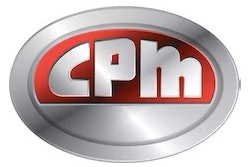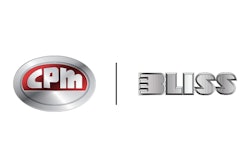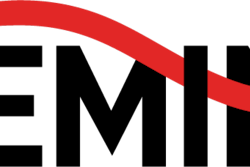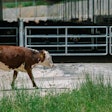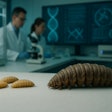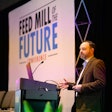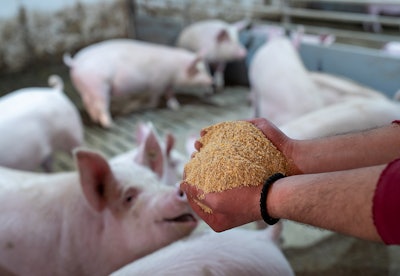
Climbing rates of contagious animal diseases and rising consumer preferences for antibiotic-free meat are raising feed mill sanitation standards to new heights. While feed contamination is rarely linked to the transmission of diseases like African swine fever (ASF) or highly pathogenic avian influenza (HPAI), food safety concerns have made feed mill sanitation a high priority in the United States.
Feed manufacturers can even add value to their product by achieving human food-grade status, meaning they produce feeds with quality high enough for human consumption.
One example is Central Valley Ag (CVA), headquartered in York, Nebraska. CVA plans to transition its Duncan, Nebraska, facility to an antibiotic-free feed mill, where it will produce supplements, minerals and complete feeds for poultry, swine and beef. Upon completing its antibiotic-free certification, the plant will meet human food-grade manufacturing standards, according to a CVA announcement.
"There are stringent certifications and practices we have to meet in order to be labeled as antibiotic free. They require regularly scheduled, third-party audits to verify we have met these certifications before the mill is able to start producing feed,” the announcement stated.
Additionally, a Hazard Analysis and Critical Control Points (HACCP) plan must be in place for human food-grade facility traceability requirements. A HACCP plan involves mapping pathogen transmission through feed along the entire production chain to reveal critical points at which the risk of contamination and recontamination are highest.
One of the earliest risks facing feed producers is the variable quality of feed ingredients containing varying microbial loads, said Dr. Enrique Montiel, global director of nutrition and live production for Anitox, a global supplier of feed sanitizers within its feed pathogen control portfolio.
The first step in ensuring feed safety is to assess the risk level of microbial contamination, especially in incoming ingredients that may have high microbial loads.
Ingredient assessments for pathogen control
Montiel said ingredients used for feed manufacturing — specifically oilseeds, animal proteins and cereal grains — typically carry higher microbial loads and pathogen prevalence than other ingredients.
“Microbial loads in raw materials vary through growing seasons and regions as well as transport and storage conditions,” Montiel said. “Therefore, pathogens entering the feed manufacturing process via contaminated ingredients can persist and thrive in feed during production and even after it reaches the farm.”
It is important to rank raw materials based on their contamination risk and determine if a feed pathogen control solution should be applied before using the ingredients. This risk assessment is crucial for developing a comprehensive feed biosecurity program aimed at consistently producing high-quality feed or achieving human food-grade facility certification.
In some cases, regular treatment of high-risk materials may be necessary. Montiel said failing to take this first step can lead to feed contamination and recontamination.
“Microbial contamination introduced in mills can lead to microbial growth niches called resident or legacy bacteria,” he said. “Pathogen prevalence and microbial loads are typically highest in feed production before pelleting. During conditioning and pelleting, we find that the level of bacteria is transiently reduced. However, the cooling period can create a condition in which persisting bacteria begin to thrive, becoming a source of recontamination.”
Feed contamination prevention and sanitation interventions
Dillon Mellick, technical service manager for Kemin Animal Nutrition and Health – North America, a feed sanitation solutions provider, said there are several effective ways to intervene and prevent resident or legacy bacteria from forming.
“Point-in-time interventions include heat treatment through pelleting or irradiation,” Mellick said. “These strategies work the moment they are used and can be effective at reducing pathogen load.”
Feed sanitizing equipment can be used during manufacturing to heat treat feed, holding it at a critical temperature long enough to eliminate Salmonella or other known pathogen risks at a facility.
A feed Hygeniser system was donated to the Iowa State University Kent Feed Mill and Grain Science Complex by CPM Automation in 2022. The Hygeniser at ISU features a parallel conditioning system with a hot-start feed conditioner that either feeds into or bypasses the pellet mill, in addition to a feed conditioner plus retentioner, providing the ability to sanitize mash or pelleted feed.
Effective feed sanitizers significantly reduce feed and feed ingredient microbial loads, while providing continued protection against contamination.
Alternatively, residual interventions can help prevent recontamination or cross contamination.
“Chemical treatments of feed and feed ingredients fall into this category and are proven to eliminate pathogens and viruses in contaminated feed,” Mellick said. “Residual chemical treatments are very effective and provide more lasting protection over a period of time.”
Keeping facilities and equipment clean can also mitigate the establishment of resident bacteria. Handling of dust and air is another important component that can be easily overlooked.
Montiel said mill flushing procedures utilizing effective chemistry can be an effective intervention, in addition to monitoring ingredient microbial quality as part of a mill’s ingredient acceptance criteria.
Proper handling and transportation of feed and ingredients also play a significant role in minimizing the risk of feed contamination.
“The risk of people introducing pathogens is not a new concept, but it is one that can be difficult to control for feed manufacturers and in a feed mill environment,” said Dr. Mark Bienhoff, DVM, pathogen control team lead for Kemin Animal Nutrition and Health – North America. “Having clean and dirty demarcations in a feed mill and preventing movement between these areas for employees may be difficult to implement. Additionally, the back-and-forth movement of people and trucks between feed mills and farm locations is a demonstrated risk and route of contamination.”
Addressing these challenges effectively through biosecurity programs in conjunction with chemical or other sanitation interventions are critical requirements for human food-grade feed mills.
Investment in the evolution of feed sanitation
Awareness of the importance of feed as a vehicle for transmission of pathogens has increased significantly over the past five years and will continue to grow. Montiel said Anitox continues to invest in understanding how implementing effective feed pathogen control will enhance producers’ ability to make safe food more efficiently while generating return on investment through performance improvement.
"We continue to partner with industry leaders, invest in R&D and ensure that we support producers in their efforts to make more safe food efficiently and sustainably,” Montiel said. “We look forward to innovating more effective solutions and strategies to do so.”
The evolving characteristics of bacteria and diseases will also shape future feed sanitation intervention options.
“Bacterial and viral pathogens continue to evolve, and many of the technologies we have historically relied upon are no longer available, making it more critical than ever to implement effective solutions at the most impactful time,” Montiel said.
Bienhoff agreed that, as livestock and poultry production and genetics evolve, diseases and their risks will change.
“Over the next decade, we foresee a more proactive attitude being adopted in terms of biosecurity — including the feed piece,” Beinhoff said. “This reflects the shift from a ‘diagnosis and treatment’ mindset to a ‘prevention and control’ mindset in veterinary medicine as well. Preventing pathogens from ever entering a facility means less disease, more efficient production, improved overall animal health and welfare and, ultimately, a boost to the bottom line. The responsible producer of the future will need to address and lower controllable risks to be more sustainable and successful in a changing market.”
Even with the effective solutions already available today, there is a spotlight on innovation in this space.
“Feed offers unique challenges, and it can be difficult to identify chemicals that provide a consistent response,” Mellick said. “At Kemin, we recognize the need for continuous investment and innovation in pathogen control solutions to address these ever-increasing challenges, and we will continue to bolster our portfolio of research related to feed biosecurity.”
A proactive approach to biosecurity, including feed sanitation, emphasizes prevention in conjunction with intervention to optimize pathogen control. Through increased investment in research and innovation, animal health threats posed by feed contamination will be addressed more effectively throughout the manufacturing process.



